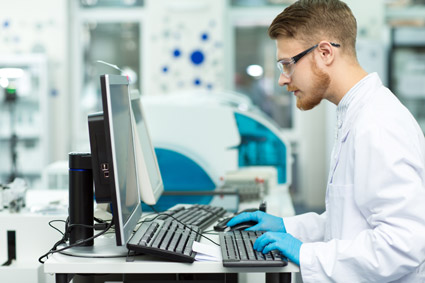Gene expression analysis
Overview
Gene expression is the conversion of heritable, genetic information into RNA or protein. Temporal and spatial differences in gene expression are important measures for understanding biological systems, including normal development and disease progression.

What is gene expression?
Gene expression is the process of using information encoded in genes to synthesize a functional gene product. Genes are transcribed into RNA which is typically translated into a functional protein. RNA may also not encode a translated protein sequence. These RNAs – untranslated RNAs – serve as functional RNA end products that can also control gene expression and protein translation. These include non-coding RNAs (ncRNAs), long, non-coding RNAs (lncRNAs), cellular RNA catalysts such as rRNAs or tRNAs, or small non-coding RNAs such as microRNAs or short-interfering RNAs (siRNAs).
What is gene expression analysis?
Gene expression analysis quantifies either messenger RNA (mRNA) levels or non-translated, functional RNA transcription levels in a cell. Whether an RNA is translated into protein or used directly in the cell, RNA transcript levels can provide important insights into how a cell or cells are functioning.
Why measure gene expression?
Linking the expression of genes of interest to a biological process or phenotype helps scientists understand gene function, biological pathways, and the genes that regulate development, cell behavior and signaling. The gene expression patterns, or “gene signatures”, associated with a biological state can serve as biomarkers for that condition. Determining changes in gene activity resulting from environmental and physical alterations can be used to generate hypotheses regarding diverse biological processes. These investigations can facilitate research efforts to develop novel solutions for diverse biological challenges. In agriculture, for example, changing expression levels can identify environmental conditions under which crops are induced to thrive, become susceptible to disease or pests, or environmental conditions that stress crop growth and development.
How is gene expression measured?
Measuring gene expression has traditionally involved isolating an intact RNA fraction from samples, immobilizing it, and quantifying the RNA transcripts of interest. This is usually done using a transcript-specific, labeled probe in a technique known as northern blotting. Gene expression analysis techniques that use this approach have been limited by their ability to study only a few transcripts per experiment. Other techniques include dot blotting, ribonuclease protection assays (RPAs), serial analysis of gene expression (SAGE), and differential or subtractive hybridization.
Newer approaches provide more high-throughput analyses of gene expression levels than immobilized RNA techniques. The commonly used techniques include quantitative PCR (qPCR), digital PCR (dPCR), and next generation sequencing (NGS).
Get started with gene expression using qPCR
One of the most widely used methods for analyzing gene expression is qPCR, also called real-time PCR. qPCR is performed as a one step or two step process. One‑step qPCR requires converting the RNA into DNA (called cDNA), then measuring the resulting cDNA concentration. All of this is done in a single tube. Two‑step qPCR also requires the RNA to be reverse transcribed into cDNA, using a reverse transcriptase, and then the cDNA is transferred into a separate tube for a subsequent qPCR reaction.
IDT offers a selection of qPCR reagents for gene expression analysis. Order ready-to-use PrimeTime™ qPCR Assays or you can design your own custom assay. Both probe-based and intercalating-dye based options are available.
Real-time qPCR guide
Familiarize yourself with critical parameters of qPCR assay design, specificity analysis, data interpretation, and troubleshooting. This complete 62-page guide covers every aspect of probe-based qPCR assays.


 Processing
Processing